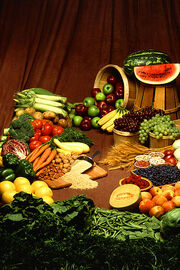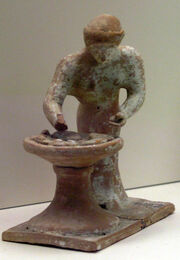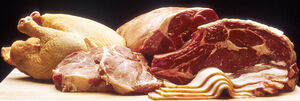
Picture of foods from vegetable, herb, and fruit sources (from Department of Agriculture).
Phaeselis is a city of four different human cultures, with a number of non-humans living in the city as well. What you get a cosmopolitan city of various tastes. All with people who can cook with the same ingredients and come up with different dishes. Although, the first thing to realize that the human is a diurnal cursory hunter. During the Stone Age, we hunted and gathered our food. Farming is a neolithic invention (the bible comments that Adam the first Man, was actually a pastoral shepherd. It's his son Cain was the first to be mentioned as a tiller of the ground or farmer -- farming isn't bad by the way, just that Cain was the first mentioned in the bible to be a farmer).
So, due to the amount of arable land only extends to about ten miles in all directions, Phaselis is a Principality that has to import it's food from other parts of the world. You have a cosmopolitan city where food is concerned. Despite this, being on the edge of the sea, food in Phaeselis depends on three staples: wheat, olives, and grapes.
Meals[]
The Hellenes in Phaeselis eat three to four meals per day. This custom has spread to other parts in the city including to the non-humans. Although the lizardmen have a hard time adopting it since they are cold-blooded creatures. Breakfast (ἀκρατισμός akratismos) consisted of barley bread dipped in wine (ἄκρατος akratos), sometimes complemented by figs or olives. They also made pancakes called τηγανίτης (tēganitēs), ταγηνίτης (tagēnitēs) or ταγηνίας (tagēnias), all words deriving from τάγηνον (tagēnon), "frying pan". The earliest attested references on tagenias are in the works of the 5th century BC poets Cratinus and Magnes. Tagenites were made with wheat flour, olive oil, honey and curdled milk, and were served for breakfast. Another kind of pancake was σταιτίτης (staititēs), from σταίτινος (staitinos), "of flour or dough of spelt", derived from σταῖς (stais), "flour of spelt". Athenaeus in his Deipnosophistae mentions staititas topped with honey, sesame and cheese. A quick lunch (ἄριστον ariston) was taken around noon or early afternoon. Dinner (δεῖπνον deipnon), the most important meal of the day, was generally taken at nightfall. An additional light meal (ἑσπέρισμα hesperisma) was sometimes taken in the late afternoon. Ἀριστόδειπνον / aristodeipnon, literally "lunch-dinner", was served in the late afternoon instead of dinner.
Men and women took their meals separately. When the house was too small, the men ate first, the women afterwards. Slaves waited at dinners. Aristotle notes that "the poor, having no slaves, must use their wives and children as servants". The ancient Greek custom to place terra cotta miniatures of their furniture in children's graves gives us a good idea of its style and design. The Greeks normally ate while seated on chairs; benches were used for banquets. The tables, high for normal meals and low for banquets, were initially rectangular in shape. But by the 4th century BCE, the usual table was round, often with animal-shaped legs (for example lion's paws). Loaves of flat bread could be used as plates, but terra cotta bowls were more common. Dishes became more refined over time, and by the Roman period plates were sometimes made out of precious metals or glass. Cutlery was not often used at table: Use of the fork was unknown, people ate with their fingers. Knives were used to cut the meat. Spoons were used for soups and broths. Pieces of bread (ἀπομαγδαλία apomagdalia) could be used to spoon the food or as napkins, to wipe the fingers.
Social dining[]
As with modern dinner parties, the host could simply invite friends or family; but two other forms of social dining were central in ancient Greece: the entertainment of the all-male symposium, and the obligatory, regimental syssitia.
Symposium[]

Symposium by Anselm.
The symposium (συμπόσιον symposion), traditionally translated as "banquet", but more literally "gathering of drinkers", was one of the preferred pastimes for the Greeks. It consisted of two parts: the first dedicated to food, generally rather simple, and a second part dedicated to drinking. However, wine was consumed with the food, and the beverages were accompanied by snacks (τραγήματα tragēmata) such as chestnuts, beans, toasted wheat, or honey cakes; all intended to absorb alcohol and extend the drinking spree.
The second part was inaugurated with a libation, most often in honor of Dionysus, followed by conversation or table games, such as kottabos. The guests would recline on couches (κλίναι klinai); low tables held the food or game boards. Dancers, acrobats, and musicians would entertain the wealthy banqueters. A "king of the banquet" was drawn by lots; he had the task of directing the slaves as to how strong to mix the wine. With the exception of Courtesans, the banquet was strictly reserved for men. It was an essential element of Greek social life. Great feasts could only be afforded by the rich; in most Greek homes, religious feasts or family events were the occasion of more modest banquets. The banquet became the setting of a specific genre of literature, giving birth to Plato's Symposium, Xenophon's work of the same name, the Table Talk of Plutarch's Moralia, and the Deipnosophists (Banquet of the Learned) of Athenaeus.
Syssitia[]
The syssitia (τὰ συσσίτια ta syssitia) were mandatory meals shared by social or religious groups for men and youths, especially in Crete and Sparta. They were referred to variously as hetairia, pheiditia, or andreia (literally, "belonging to men"). They served as both a kind of aristocratic club and as a military mess. Like the symposium, the syssitia was the exclusive domain of men — although some references have been found to all-female syssitia. Unlike the symposium, these meals were hallmarked by simplicity and temperance.
Foods[]
Bread[]

Woman kneading bread by Marsayas.
Cereals formed the staple diet. The two main grains were wheat (σῖτος sitos) and barley. Wheat grains were softened by soaking, then either reduced into gruel, or ground into flour (ἀλείατα aleiata) and kneaded and formed into loaves (ἄρτος artos) or flatbreads, either plain or mixed with cheese or honey. Leavening was known; the Greeks later used an alkali (νίτρον nitron) or wine yeast as a leavening agent. Dough loaves were baked at home in a clay oven (ἰπνός ipnos) set on legs. A simpler method consisted in putting lighted coals on the floor and covering the heap with a dome-shaped cover (πνιγεὐς pnigeus); when it was hot enough, the coals were swept aside, dough loaves were placed on the warm floor, the cover was put back in place and the coals were gathered on the side of the cover.[ (This method is still traditionally used in Serbia and elsewhere in the Balkans, where it is called crepulja or sač). The stone oven did not appear until the Roman period. Solon, an Athenian lawmaker of the 6th century BCE, prescribed that leavened bread be reserved for feast days. By the end of the 5th century BCE, leavened bread was sold at the market, though it was expensive.
Barley was easier to produce but more difficult to make bread from. It provided a nourishing but very heavy bread. Because of this it was often roasted before milling, producing a coarse flour (ἄλφιτα alphita) which was used to make μᾶζα maza, the basic Greek dish. In Peace, Aristophanes employs the expression ἔσθειν κριθὰς μόνας, literally "to eat only barley", with a meaning equivalent to the English "diet of bread and water". Many recipes for maza are known; it could be served cooked or raw, as a broth, or made into dumplings or flatbreads. Like wheat breads, it could also be augmented with cheese or honey.
Fruit and Vegetables[]
The cereals were often served accompanied by what was generically referred to asὄψον opson, "relish". The word initially meant anything prepared on the fire, and, by extension, anything which accompanied bread. In the classical period it came to refer to fruit and vegetables:cabbage, onions, lentils, sweet peas, chickpeas, broad beans, garden peas, grass peas, etc. They were eaten as a soup, boiled or mashed (ἔτνος etnos), seasoned with olive oil,vinegar, herbs or γάρον gáron, a fish sauce similar to Vietnamese nước mắm. According to Aristophanes, mashed beans were a favourite dish of Heracles, always represented as a glutton in comedies. Poor families ate oak acorns (βάλανοι balanoi). Raw or preserved olives were a common appetizer.
In the cities, fresh vegetables were expensive: the poorer city dwellers had to make do with dried vegetables. Lentil soup (φακῆ phakē) was the workman's typical dish. Cheese, garlic and onions were the soldier's traditional fare. In Peace, the smell of onions typically represents soldiers; the chorus, celebrating the end of war, sings Oh! joy, joy! no more helmet, no more cheese nor onions! Bitter vetch was considered a famine food.
Fruits, fresh or dried, and nuts, were eaten as dessert. Important fruits were figs, raisins and pomegranates. Dried figs were also eaten as an appetizer or when drinking wine. In the latter case, they were often accompanied by grilled chestnuts, chick peas, and beechnuts.
Fish and Meats[]

Meat food group photo from the National Institute of Health.
Aryavartan Cuisine[]

Tandoori Chicken.
Aryavartan cuisine has some similarities to Indian cuisine. The use of fruit, vegetables, grain, dairy products, honey, and sometimes meat is on the menu. In the Aryavartan quarter, the Aryavartans enjoy spicy foods with spices shipped in from Aryavarta. Aryavartan cuisine resembles cuisine from the Punjab of India. The cuisine includes:
Breakfast[]
- Paratha
- Halwa poori
- Falooda
- Lassi
Non-Vegetarian[]
- Chicken: Tandoori Chicken, Butter Chicken, Chicken Tikka
- Lamb: Rogan Josh, Bhuna Gosht, Kadhai Gosht, Raan Gosht, Dal Gosht, Saag Gosht, Nihari Gosht, Rara Gosht, Paye da Shorba
- Freshwater fish dishes like Amritsari Fish, Tandoori Fish, Fish Tikka, Fish Pakora
- Kebabs: lamb, chicken and beef chunks
- Biryanis: lamb, chicken, and beef variations
- Kheema: braised minced lamb or beef meat, commonly served with naan
- Kunna Gosht: meat prepared in Kunna (mitti ka bartan)
- Paye: Siri Paye
Vegetarian[]
- Pulse, bean and/or lentil preparations:
- Sarson Da Saag|sarson da saag (a dish prepared from green Mustard plant|mustard leaves) and with makki di roti, a bread made by corn flour
- Edible Mushroom and bean sabzi
- Dal makhani (lentils with cream and butter)
- rajma (red kidney bean) and rice
- rongi (Black-eyed peas)
- chickpeas (eaten with naan or kulcha)
- aloo (eaten with puri)
- Kadhi Pakora (traditional curry with pakoras) and rice (Kadhi is a type of curry made by cooking garamflour with curd or buttermilk. Fried lumps (pakoras) of gramflour with salt and chillies are also added.)
- Paneer dishes like Shahi Paneer, and Khoya paneer
- Sweet dishes like Phirni, Jalebi, Malpua, Sheer korma
- Snacks like pakoras which is eaten with green chutney also called as pudine ki chutney, and samosas
Breads[]
Punjabi breads are both flat (unleavened) breads as well as raised breads. The breads may be made of different types of flour and can be made in various ways:
- Baked in the tandoor like naan, Tandoori roti, Kulcha, or Lachha Paratha
- Dry baked on the Tava (Indian griddle) like Phulka or Chapati, jowar ki roti, baajre ki roti and Makki ki roti (these are also smeared with white butter)
- Shallow fried like Paratha, Keema Paratha, Potato or Radish Paratha
- Deep fried like Puri and Bhatoora (a fermented dough)
- Naan is also very popular.
Achaemeniad Cuisine[]
The Cuisines of the people of Ariya resembles Iranian or Persian cuisine. Achaemeniad cuisine depends on rice as a staple.
Videos[]
>

